Mapping Success: A Guide to Location Intelligence in Retail
Why Location Intelligence is Changing Retail Decision-Making
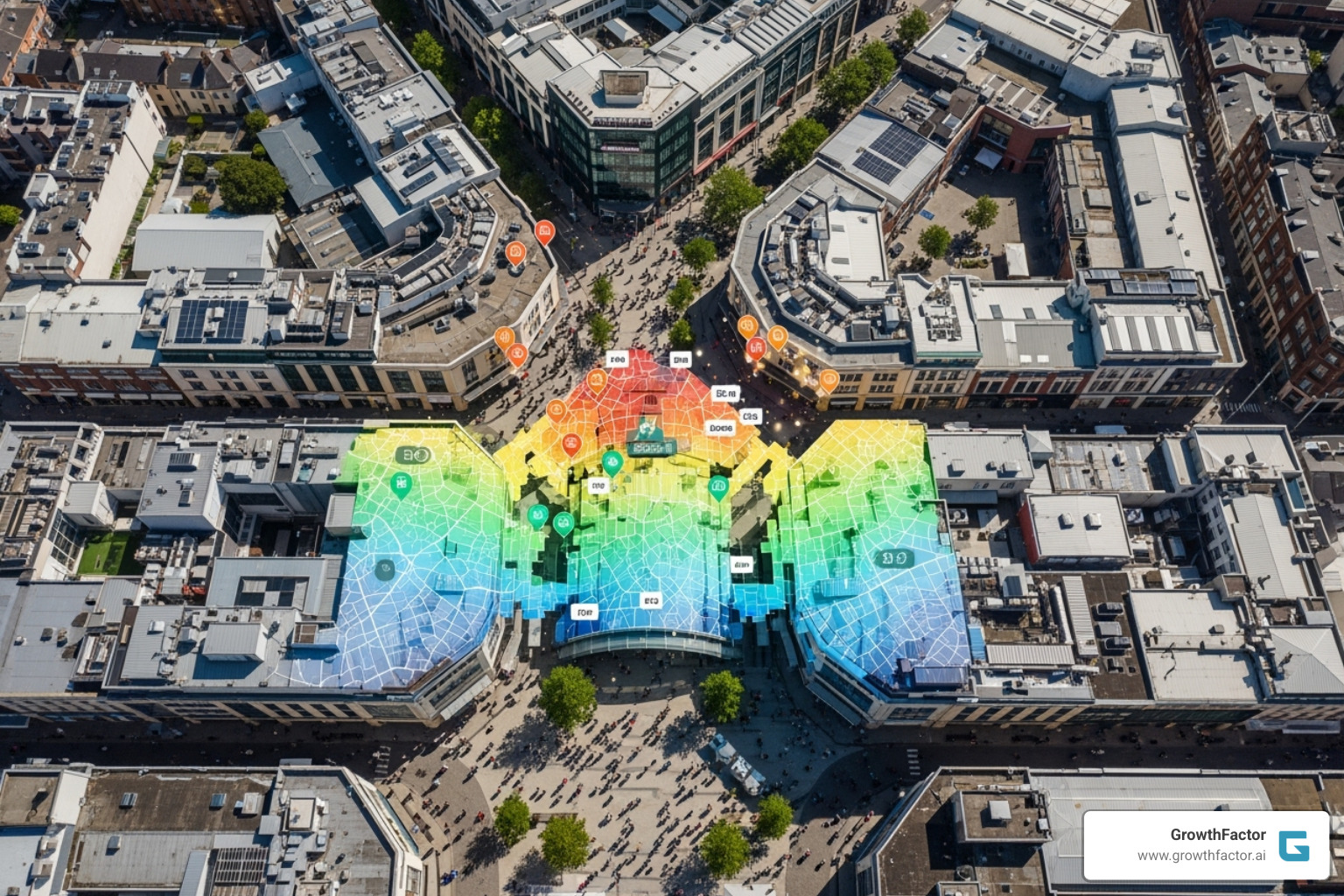
Location intelligence for retail is revolutionizing how brick-and-mortar stores make expansion decisions, moving from gut instincts to data-driven strategies that dramatically improve success rates. The retail landscape has fundamentally shifted. What Mike Cavender, Co-Owner and Head of Real Estate at Cavender's Western Wear, calls the end of "black-box models that are hard to trust" represents a broader movement toward transparent, actionable location intelligence.
The numbers tell the story: 98% of retail CEOs consider location intelligence crucial to their business goals, while the global location analytics market is projected to grow from $20.6 billion in 2023 to $38.5 billion by 2028. This isn't just about technology adoption—it's about survival in a competitive market where every location decision can make or break expansion plans.
Modern retailers are finding that location intelligence solves their most pressing challenges: analyzing thousands of potential sites efficiently, reducing the time from evaluation to grand opening, and making expansion decisions with confidence. As Clyde Christian Anderson, Founder and CEO of GrowthFactor.ai, I've seen how location intelligence for retail transforms growing chains from reactive to proactive expansion strategies, having helped clients achieve 99.8% success rates in new store openings. The future belongs to retailers who can turn location data into a competitive advantage.
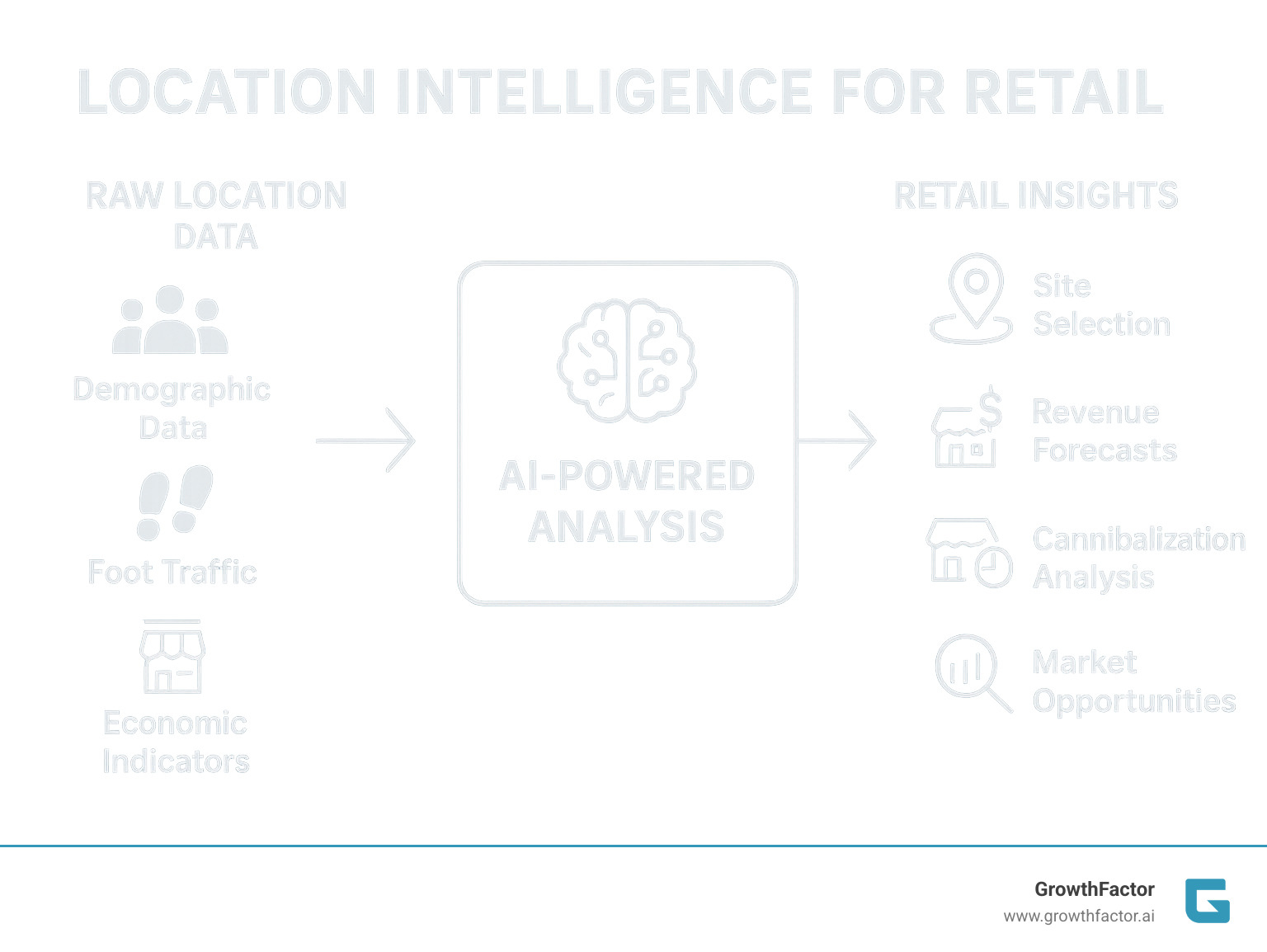
Location intelligence for retail terms explained:
What is Location Intelligence and Why is it a Retail Game-Changer?
Think of location intelligence for retail as your business data getting a GPS upgrade. It’s the process of placing valuable information about customers, sales, and operations onto a map with rich context layers. This isn't just about plotting dots on a screen—it's about understanding the why behind where your customers shop, the when of their purchasing patterns, and the how of their location-influenced behavior. Since every retail transaction happens somewhere, location shapes every part of the retail experience, making location intelligence essential. For a neutral primer, see Location intelligence.
The data confirms this shift. The global location analytics market is projected to grow from $20.6 billion in 2023 to $38.5 billion by 2028, a compound annual growth rate of 13.4%. Furthermore, 98% of retail CEOs consider location intelligence crucial to their business goals. This represents a fundamental change from "I think this location looks good" to "The data shows this location will perform well, and here's exactly why."
Understanding the Core Benefits for Retailers
Location intelligence for retail transforms nearly every aspect of business. Strategic site selection becomes a science, using data on demographics, foot traffic, and competitor presence to identify optimal locations and reduce risk. It also enables improved store layouts by revealing how customers move through a space, maximizing both experience and sales. Marketing becomes more effective through targeted, personalized messaging based on neighborhood-specific preferences. Retailers gain a clear view of the competitive landscape, identifying market gaps and trade area overlaps. Finally, operational efficiency improves across the board, from optimizing delivery routes to staffing stores based on actual traffic patterns, all leading to better, informed decision-making. For more insights, explore our guide to AI-Powered Retail Analytics.
From Gut-Feeling to Geo-Data: The Evolution of Retail Decisions
For generations, retail expansion was guided by an experienced professional's "feel" for a neighborhood. This traditional, experience-based approach was subjective, difficult to scale, and hard to validate. Knowledge didn't transfer easily, and decisions were often inconsistent.
Today's data-driven approach changes everything. Instead of evaluating a few dozen sites, retailers can analyze thousands using comprehensive datasets on demographics, spending, and mobility. This evolution brings dramatically increased accuracy, allowing retailers to predict performance with confidence. The analytical framework scales beautifully, making rapid expansion both feasible and less risky. This shift from intuition to intelligence is a fundamental change in how smart retailers approach growth. Our article on AI for Real Estate explores how this revolution extends across industries.
Strategic Growth: Using Location intelligence for retail
For strategic retail growth, it's not about adding more stores—it's about opening the right stores in the right locations. Location intelligence for retail provides a clear roadmap for smart expansion and peak performance. It acts like X-ray vision for the market, revealing opportunities and risks to clarify complex decisions.
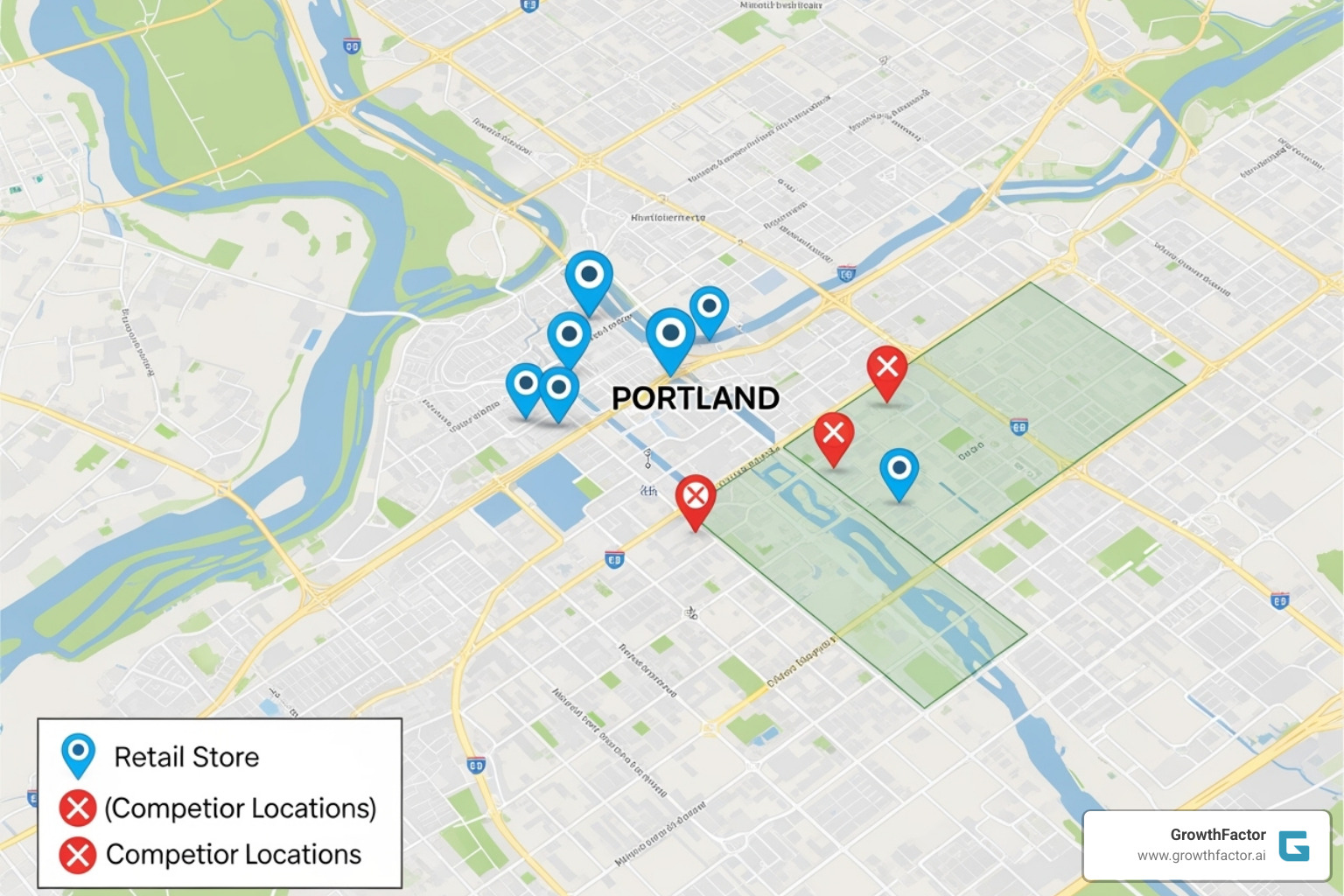
From finding untapped markets to balancing your existing store network, location intelligence empowers data-backed choices. To dive deeper into how data drives these decisions, check out our guide on Data-Driven Site Selection.
Mastering Site Selection and Expansion
Successful retail expansion begins with mastering site selection: identifying high-potential markets that match your target customer and business model. With location intelligence for retail, you can perform advanced whitespace analysis to pinpoint areas with strong demand and low competition. By analyzing details like accessibility and visibility, you can accurately forecast performance. Our AI Agent Waldo, for example, helps clients evaluate five times more potential sites with incredible efficiency by automating qualification steps that once took weeks. This allows you to move faster and with greater confidence. To learn more, visit What is Site Selection and explore tools in our insights on Retail Expansion Planning Software.
Optimizing Your Store Network and Managing Cannibalization
As a retail network grows, the focus shifts to portfolio optimization. Location intelligence for retail is invaluable for monitoring the health of your entire store network, identifying underperforming stores that may need a strategic boost, relocation analysis, or closure. This process helps you understand and avoid the cannibalization impact, where a new store pulls sales from a nearby existing location. By defining a Trade Area for each store and analyzing customer overlap, you can place new stores to complement, not compete with, your current ones. This helps avoid market saturation and right-size your portfolio, ensuring each store contributes optimally to your success.
Predicting Future Trends and Consumer Behavior
Retail is constantly changing. Location intelligence for retail provides powerful predictive modeling to stay ahead. We can forecast future foot traffic patterns, identify emerging hotspots with growing populations or changing spending habits, and understand migration patterns that signal new market opportunities. By analyzing these trends, you can proactively adjust your product selection, store designs, or marketing efforts. This forward-looking approach helps you anticipate customer needs and position your business for long-term success. For more on how data reveals these shifts, explore our Real Estate Data Insights.
The Data-Driven Advantage: Key Data Types and Applications
The power of location intelligence for retail comes from integrating diverse data types. When combined, these pieces create a comprehensive picture of a market, customer, or potential site. Effective data integration, combining internal sales data with external market intelligence, is what enables truly informed decisions.
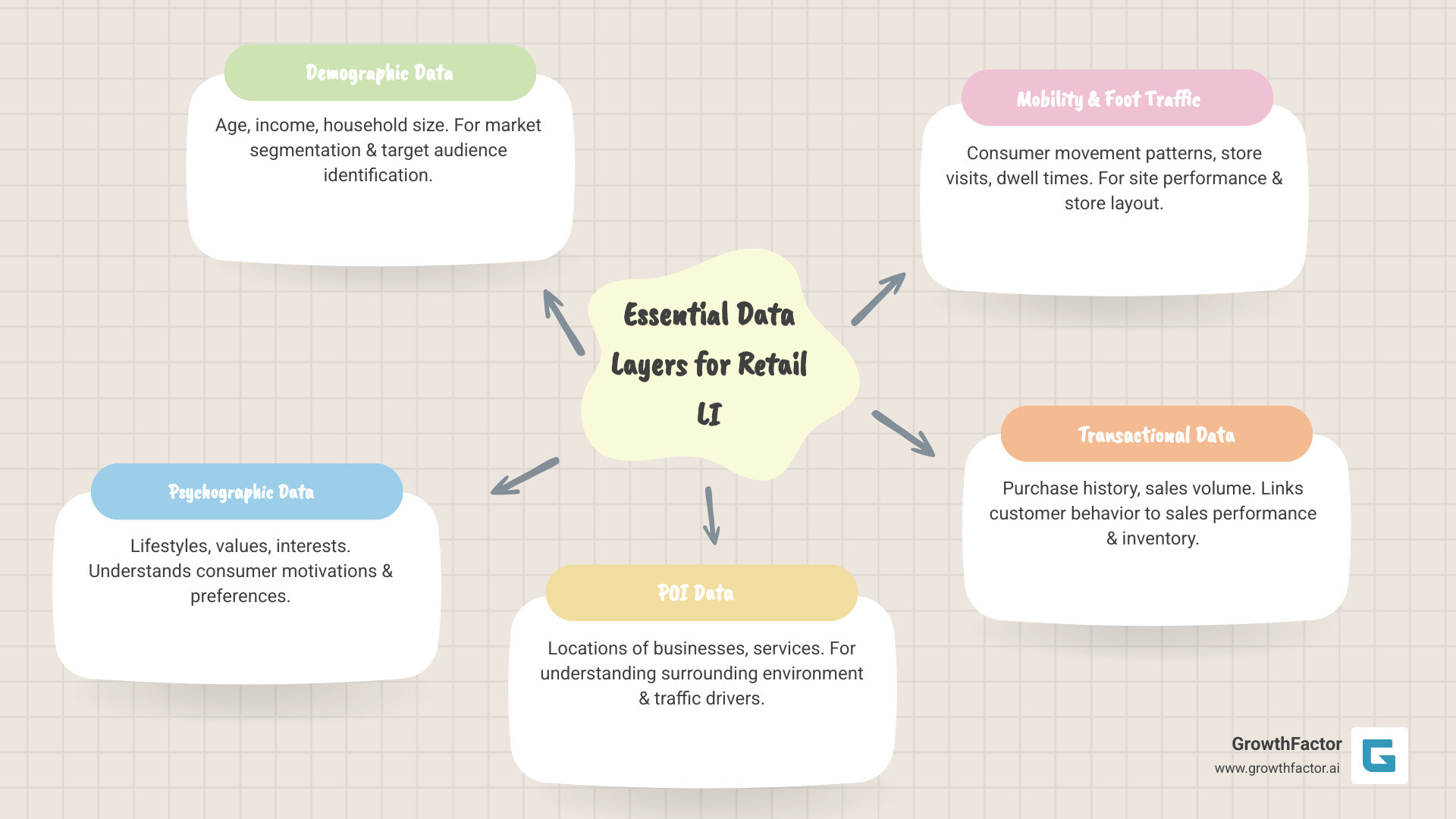
This holistic view allows us to make smarter choices, from site selection to personalized marketing. Dive deeper into the data that powers these decisions with our insights on Site Selection Data.
Unpacking the Essential Data Layers
A robust location intelligence strategy relies on several key data types:
- Demographic Data: Population characteristics like age, income, and education level help us understand who lives in an area and their spending capacity.
- Psychographic Data: This data digs into consumer lifestyles, values, and interests to reveal why people make certain purchasing decisions.
- Point of Interest (POI) Data: Mapping other businesses and landmarks helps us understand the competitive landscape, identify complementary businesses, and assess traffic generators.
- Mobility and Retail Foot Traffic Data: This dynamic dataset tracks how people move through an area, telling us how many potential customers are passing by. Find out more in our guide to Retail Foot Traffic Data.
- Transactional Data: Your own sales and loyalty program data provide insights into what customers are buying and how often.
- Competitor Data: Information on competitor locations and performance helps us understand market saturation and identify strategic opportunities.
For a comprehensive guide to understanding your potential customer base, explore Site Demographics: Complete Guide.
How data informs targeted marketing and customer segmentation
With rich data layers, marketing transforms from broad strokes to precision targeting. Location intelligence for retail enables highly effective hyperlocal campaigns, such as using geofencing to send an offer to a customer's phone as they approach a store. By combining demographic, psychographic, and mobility data, we can create sophisticated customer profiles for personalized promotions that resonate with local communities. This alignment significantly increases marketing ROI and drives foot traffic. For more on the tools that make this possible, check out our insights on Location Intelligence Software.
Streamlining the Supply Chain and Inventory Management
The benefits of location intelligence for retail extend to optimizing the supply chain. By analyzing sales and foot traffic data by location, we can more accurately forecast demand for specific products in specific areas. This allows us to optimize stock levels at each store, meeting demand without overstocking. Furthermore, location intelligence helps improve last-mile delivery by identifying the most efficient routes, reducing transportation costs. This level of precision means happier customers and a healthier bottom line.
Enhancing the Customer Journey and Boosting Performance
The magic of location intelligence for retail truly comes alive when we see how it transforms the actual shopping experience. Every customer who walks through our doors is on a journey, and understanding that journey through data helps us create moments that matter. It's not just about getting people in the door anymore - it's about making their visit so engaging and efficient that they want to come back.
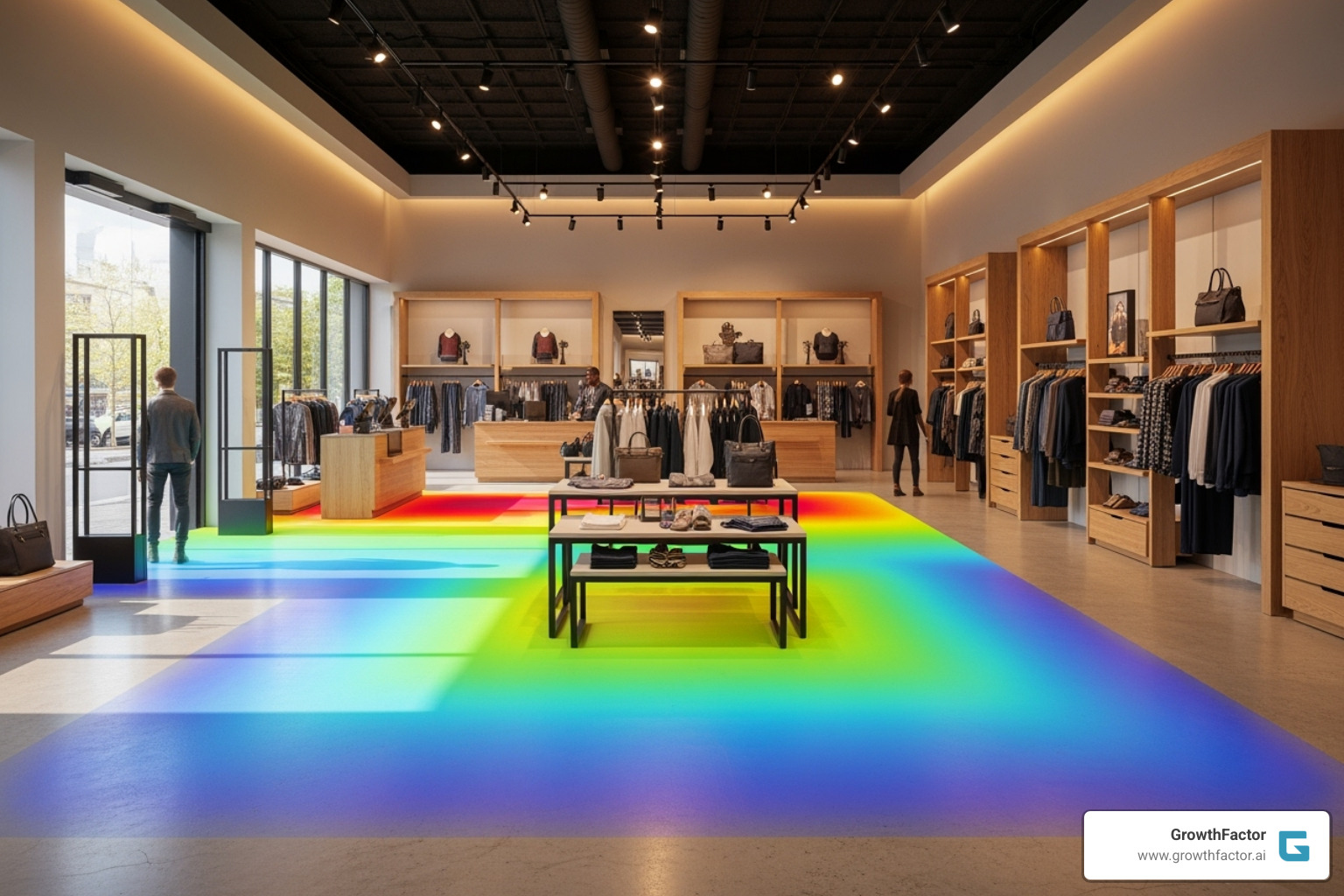
When we analyze how customers move through our stores, we uncover patterns that would be invisible otherwise. Maybe shoppers consistently get stuck at a certain corner, or perhaps they're spending more time in areas we hadn't considered prime real estate. This insight becomes our roadmap for optimizing everything from store layout optimization to merchandising strategies. For retailers looking to dive deeper into these patterns, our guide on Foot Traffic Analytics reveals how to turn movement data into actionable improvements.
Driving In-Store Traffic and Enhancing Customer Experience
Getting customers through the door in today's retail environment requires more finesse than ever before. Location intelligence for retail gives us the tools to create personalized in-store offers that feel timely rather than intrusive. Picture this: a customer who frequently buys running gear gets a notification about a flash sale on athletic wear just as they're walking past our store. That's proximity marketing working at its best.
But the real magic happens once they're inside. By understanding customer flow patterns, we can design layouts that feel natural and intuitive. Nobody likes getting lost in a store or waiting forever at checkout, and location intelligence helps us eliminate these friction points. We can optimize wayfinding so customers find what they need quickly, and use traffic data to improve staff allocation during busy periods.
The numbers tell an encouraging story too. Grocery remains strong, with 2.27% more traffic in recent data, showing that when we get the fundamentals right, customers respond. These routine visits give us countless opportunities to improve the experience through better store organization and strategic product placement.
Using location intelligence for retail performance analysis
Understanding performance goes far beyond counting daily sales totals. Location intelligence for retail lets us dig into the why behind our numbers. When we're benchmarking store performance across our network, we can identify which locations are thriving and, more importantly, what makes them successful.
Analyzing foot traffic patterns reveals fascinating insights about customer behavior. Are people browsing longer on weekends? Do certain demographics visit at specific times? By correlating traffic with sales, we start to see the full picture of how physical presence translates to revenue.
The retail landscape is showing some promising trends. Apparel stores had one of the strongest gains, with nearly 4% more visits, demonstrating that physical retail still has tremendous appeal when done right. This kind of performance data helps us identify high-traffic zones within our stores and make smarter decisions about where to place our best merchandise.
Understanding visit frequency and dwell time patterns also guides our merchandising strategy. If customers are spending more time in certain sections, we can improve those areas with complementary products or special displays. It's like having a conversation with our space, learning what works and what doesn't through actual customer behavior rather than guesswork.
The Future of Retail: Emerging Trends in Location Intelligence
The world of location intelligence for retail is constantly advancing, powered by new technologies. The future of retail decisions is becoming smarter and more precise thanks to rapid advancements in Artificial Intelligence (AI), Machine Learning (ML), the Internet of Things (IoT), and real-time analytics. Even Augmented Reality (AR) is beginning to play a role, offering new ways for customers to interact with products.

These emerging trends are weaving location data deeper into the fabric of retail, helping create seamless and ethical customer experiences. To get a clearer picture of what's ahead, take a peek at our insights on AI Location Intelligence.
The Role of AI and Machine Learning
Artificial Intelligence (AI) and Machine Learning (ML) are the engines driving the next wave of location intelligence for retail. These technologies make it possible to analyze thousands of potential store sites in a fraction of the time it used to take. Our AI Agent Waldo, for instance, automates much of the qualification and evaluation process, freeing up valuable time for strategic thinking. AI-powered predictive analytics are also becoming incredibly accurate, forecasting sales and spotting market potential with a precision that traditional methods cannot match. AI is also great at anomaly detection, flagging unusual foot traffic patterns or sales dips that might signal a problem—or a new opportunity.
Hyper-Personalization and Real-Time Analytics
The future of retail is hyper-personalization: knowing what a customer needs, right when they need it. This means dynamic pricing that adjusts to local demand and real-time inventory adjustments driven by current sales and foot traffic. The Internet of Things (IoT) will play a huge part, with IoT sensors on smart shelves providing instant data on product availability and customer interactions. Geofencing triggers will deliver just-in-time promotions perfectly timed to a customer's location and past shopping habits. This instant responsiveness will redefine customer expectations.
Ethical Considerations and Data Privacy
As location intelligence for retail becomes more powerful, ethics and data privacy are paramount. At GrowthFactor, we are committed to the highest standards of data protection, ensuring compliance with regulations like GDPR and CCPA and using data anonymization techniques to protect privacy. We also believe in transparency with consumers about how their data is collected and used. Building customer trust through ethical data sourcing and responsible use of location intelligence is the foundation for successful, future-proof retail operations.
Frequently Asked Questions about Location Intelligence for Retail
We often hear similar questions from retailers curious about adopting location intelligence for retail. Here are concise answers to some of the most common questions we get:
How can smaller retailers benefit from location intelligence?
Location intelligence for retail is a powerful equalizer, not just a tool for large corporations. It allows smaller retailers to make every decision count by optimizing limited resources for maximum impact. Instead of guessing, you can use data to pinpoint where your ideal customers live, identify a niche market, and see where competitors are thriving or struggling. This helps you optimize your budget and staff, making every dollar work harder. At GrowthFactor, our scalable AI-driven solutions are designed to be accessible. Our Core plan starts at just $500, making sophisticated location intelligence affordable for businesses in places like Boston, MA, or Cambridge, MA, to gain a real competitive advantage.
What is the difference between location analytics and location intelligence?
While often used interchangeably, there's a key difference. Think of it this way:
Location Analytics is the "how." It's the technical process of gathering, processing, and visualizing geographic data. It turns raw information into understandable maps and charts.
Location Intelligence is the "why" and "what's next." It's the strategic wisdom gained from that analysis. It transforms data into actionable insights that inform business decisions, helping you understand why things are happening and what you should do about it.
How accurate is foot traffic data?
Foot traffic data has become highly accurate and reliable. Its precision depends on factors like the data panel size (the number of devices data is collected from) and the validation methods used by providers. Reputable companies use rigorous data cleaning and large, diverse panels to ensure trustworthiness. While no dataset is 100% perfect, top providers often claim over 90% accuracy. This high benchmark means you can confidently use foot traffic insights for critical decisions about site selection, staffing, and marketing, giving you a powerful edge based on reliable trends.
Conclusion: Charting Your Path to Retail Success
The retail world doesn't have to feel like navigating a maze in the dark anymore. Throughout this journey, we've explored how location intelligence for retail illuminates every corner of our operations, changing uncertainty into confidence and guesswork into strategic advantage.
Think about where we started - those days of crossing our fingers and hoping a location would work out. Now we can predict performance, understand our customers' movements, and make expansion decisions backed by real data. It's like upgrading from a paper map to GPS navigation, except the stakes are your business's future.
The change touches everything we do. Smart site selection means we're not just picking locations; we're choosing success. Optimized store networks ensure every location pulls its weight without cannibalizing others. Improved customer experiences happen when we truly understand how people move through our spaces. And streamlined operations free up our time and resources for what matters most - growing our business.
This isn't about staying ahead of the competition anymore. It's about future-proofing your retail business in a world where consumer habits shift overnight and market conditions change by the hour. A robust Site Selection Strategy powered by location intelligence has evolved from nice-to-have to absolutely essential for survival and growth.
Here's the reality we face: retailers who accept data-driven decision making are thriving, while those clinging to old methods are struggling to keep up. The gap between the two approaches widens every day.
At GrowthFactor, we've built our platform around one simple belief - your expertise combined with our AI creates something powerful. Our AI Agent Waldo doesn't replace your judgment; it amplifies it. While you focus on strategy and growth, Waldo handles the heavy lifting of site qualification and evaluation, processing five times more locations than traditional methods allow.
The era of "I have a good feeling about this location" is officially over. The future belongs to retailers who can turn location data into competitive advantage, who can spot opportunities before others even know they exist, and who can make expansion decisions with confidence rather than hope.
Your path to retail success starts with embracing the power of location intelligence. The tools are here, the data is available, and the results speak for themselves. The only question left is: are you ready to revolutionize how you grow?
Find how an AI agent can revolutionize your retail site selection process
Citations
The human algorithm
Ready to see what we're cooking?
Submit your information below and we'll be in touch to schedule.







